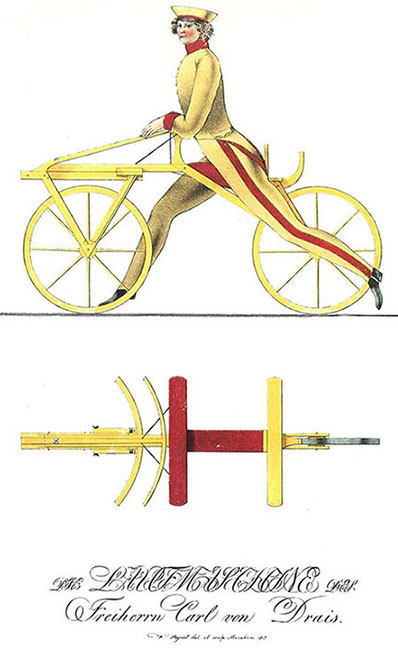A Short Illustrated History of the Bicycle
By Carsten Hoefer
The Hobby Horse: 1817 - Karl Drais and his running machine

The history of the bicycle begins with an unhappy man with a very long name: Karl Friedrich Christian Ludwig Freiherr Drais von Sauerbronn.
Born in 1785 in the southwestern German city of Karlsruhe, Baron Karl Drais was one of the most creative German inventors of the 19th century: an aristocrat who became a democrat and supported the failed revolution of 1848, a man simultaneously admired and mercilessly ridiculed by his contemporaries.
Originally a civil servant working for the Grand Duke of Badenia's forestry service, he later became a professor of mechanics.
The running machine was in effect a very primitive bicycle without a drivetrain.
 While the Draisine is not a bike in the modern sense of the word, Drais' invention marked the big bang for the bicycle's development, as British bike historian Serena Beeley argues. It was the first vehicle with two wheels placed in line.
While the Draisine is not a bike in the modern sense of the word, Drais' invention marked the big bang for the bicycle's development, as British bike historian Serena Beeley argues. It was the first vehicle with two wheels placed in line. The frame and wheels were made of wood, the steering already resembled a modern handlebar. Riders sat on an upholstered leather saddle nailed to the frame and pushed themselves forward with their feet. The contraption weighed about fifty pounds.
An instant - though short-lived - international success, the running machine became known under various names: Draisine in Germany, velocipede (fast feet) or Draisienne in France, hobby horse or dandy horse in England - an allusion to the fact that the dandy horse's riders were mostly dapper young men with too much money on their hands. On the other side of the Atlantic, American critics viewed this latest proof of European eccentricity with scepticism: Every species of transatlantic nonsense, it would seem, is capable of exciting curiosity, no matter how ridiculous, proclaimed a pundit in the Baltimore Morning Chronicle.
Drais' big democratic idea behind the running machine was to find a muscle-powered replacement for the horse that would allow large numbers of people faster movement than walking or riding in a coach. Horses were expensive, needed a groom and consumed lots of food even when not in use.
Drais undertook his first documented ride on July 12, 1817, setting out from the city of Mannheim and covering a distance of about 13 kilometers in one hour. A few months later Drais created a huge sensation when he rode 60 kilometers in four hours. Useful accessories included an umbrella and a sail for windy days.
These publicity stunts were later followed by a marketing trip to Paris, where the hobby horse quickly caught on. The fad also quickly spread to Britain. Drais also invented a number of other muscle-powered vehicles - a quad, a trike and a tandem version of the running machine. None of these vehicles were commercially successful, but Drais' ideas paved the way for future designs.

(probably the world's first bike ad)
And although Drais had been granted a privilege - an early type of patent - by the Grand Duke of Badenia in 1818, the running machine never earned a lot of money for its creator. The privilege expired after five years, and the concept of intellectual property rights was still in its infancy. Numerous wagon builders simply copied the design.
Yet Drais' idea did not disappear entirely: In 1819 British coachmaker Denis Johnson started production of an improved draisine in London. Johnson used an iron fork in front and two iron stays in the rear instead of the clunky wooden braces used by Drais. The steering was also much improved and already bore a slight resemblance to a modern headset.
And on a sidenote: The disciples of Drais are active to this very day. In 2005, avid Austrian Walter Werner rode the entire length of the Danube on a hobby horse - from the great river's source in the Black Forest to the Black Sea. It took him five months to cover a distance of more than 3,400 kilometers. Reportedly even the monks of Romania, who are familiar with all kinds of otherworldly phenomena, were stunned. In Germany modern miniature versions of the running machine have made a comeback in recent years - as "glide bikes" for two- and three-year-olds.
https://www.crazyguyonabike.com/doc/page/?page_id=40616

